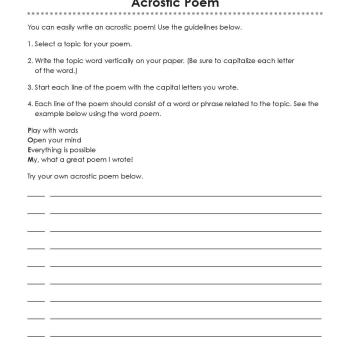Acrostic Poem

About this printout
Acrostic poems are fun to write. Your students will find constructing them easy, too, thanks to this helpful tool, which has endless possibilities for curriculum integration.
Teaching with this printout
Students in grades 3–5 will have great success writing acrostic poems. These poems do not have to rhyme but follow a specific format that reiterates such skills as spelling, vocabulary, and comprehension. Assign your students a one-word topic based on the content area in which you’re working. Students should then write that word vertically and in all capital letters; each horizontal line of the poem begins with the respective letter that makes up the word. All of the lines of the poem should relate to the one-word topic. Before having your students use this tool on their own, model an acrostic poem for them. If desired, use the example below.
Cute and soft
Always there to cuddle
Tries to jump on the table
More ideas to try
- After studying a particular topic, have each student write an acrostic poem related to the topic. Before students write, have a brainstorming session and encourage them to share words and phrases about the topic as you write them on the board. Then have students use these to inspire ideas for their poems.
- Have students write acrostics to reflect their knowledge on current events. When an event happens, such as a hurricane or an earthquake, an election, or even something at your school, students will likely want to discuss what they have seen on television or what they have read or heard. You may also want to encourage students to gather more information from newspapers, interviews, or Internet sites before they integrate that information into their acrostic poems.
- After reading a book, have each student create an acrostic poem that reflects traits of the main character. The character’s name is the one-word topic, and each line of the poem consists of a word that begins with the corresponding letter and also describes something about the character.